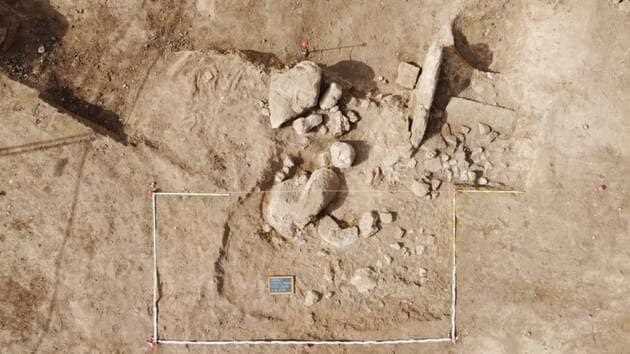The statues, dated between 950 and 730 BC, were discovered in the necropolis of Mont’e Prama in Cabras, a site of nuragic culture.
Archaeologists have discovered the torsos of two new Iron Age limestone statues of boxers at the Mont’e Prama necropolis in Cabras, Sardinia, Italy’s culture ministry said on Saturday.
Read alsoWeapons from the naval battle of Alalia between Phocaeans and Carthaginians discovered in Italy
The Minister of Culture, Dario Franceschini, considered that it was a “exceptional discovery” able to shed new light on this culture of the Iron Age (around 950 – 730 BC) whose tombs and statues have been exhumed on the archaeological site of Mont’e Prama during several excavation campaigns over the years. 1970. The bare torsos and other statue fragments have been identified as depicting pugilists, due to a shield covering their bodies. They are similar to two other statues discovered a few meters away in 2014, currently displayed in a local museum, the ministry said.
Read alsoNear Verona, a drip study of a Roman villa from Late Antiquity
Archaeologists working on the southern part of the vast necropolis, discovered in 1974 by farmers, also unearthed the extension of a funeral alley on a north-south axis, along which tombs dating from 950 had been discovered. – 730 BC. JC While the small and medium-sized fragments are exhumed and inventoried, “it will take time to free the two torsos, heavy and massive blocks, from the sediment and prepare them for recovery in good safety conditions”explained the head of the Ministry of Culture for southern Sardinia Monica Stochino.
SEE ALSO – A small chamber, probably “of slaves”, discovered in Pompeii
Read alsoIn the region of Pompeii, the hunt for antiquities looters pays off
statues of giants
The site belongs to the nuragic culture that has developed in Sardinia for centuries since the Bronze Age. This culture is characterized by the nuraghes, mysterious stone monuments that today dot the landscapes of Sardinia and whose initial function remains unknown. Thousands of larger fragments and pieces unearthed over the past decades at the Mont’e Prama site have been put together to reconstruct statues measuring two meters high.
Read alsoPreventive archaeology: 20 years of discoveries
They have been identified as those of fighters, archers or wrestlers, but archaeologists still do not know precisely what their function was. It is not known where these statues of giants were originally located before they were smashed in the time of antiquity, possibly by Phoenicians, Carthaginians or groups of Nuragic populations fighting among themselves. These fragments were scattered above and near the graves.
SEE ALSO – This rare Roman statue is returned to France 50 years after it was stolen from a museum
